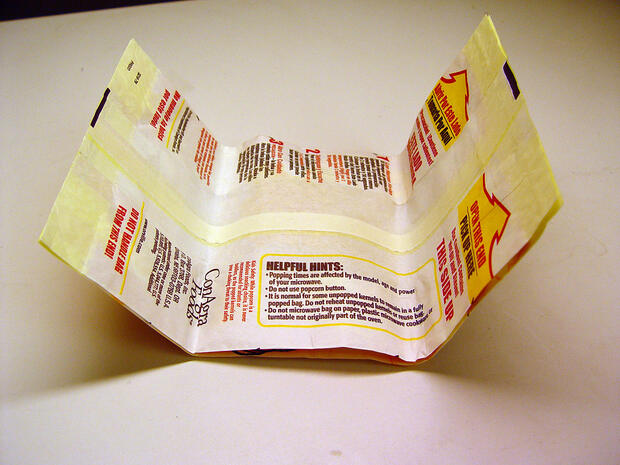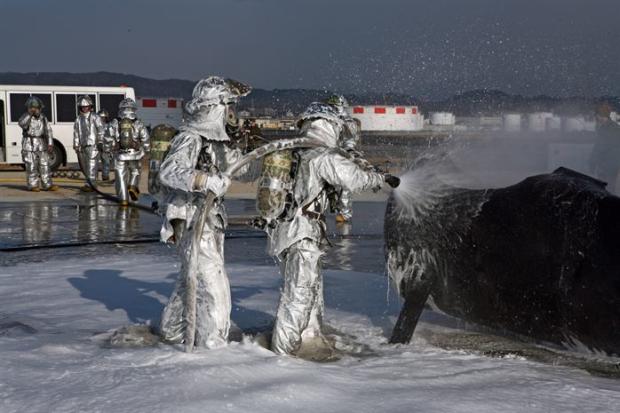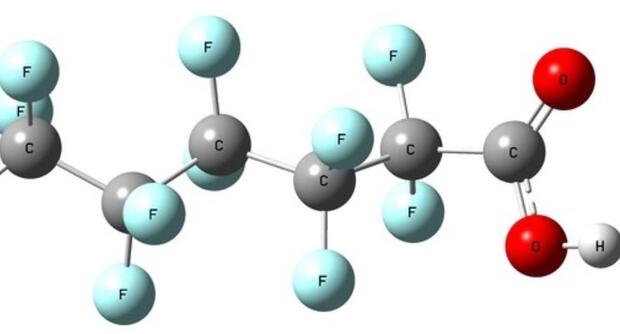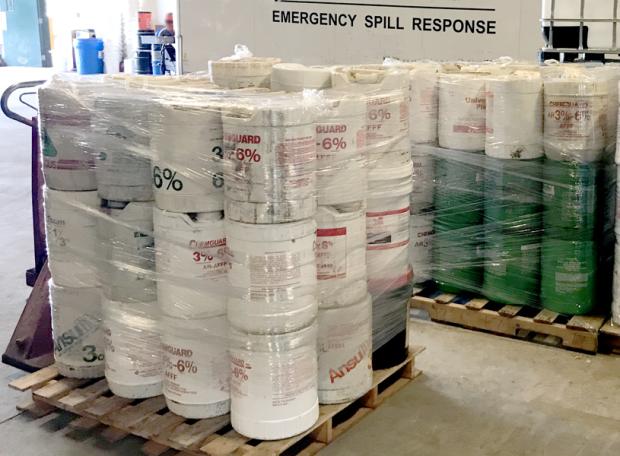What are PFAS and why are they a problem?
Per- and polyfluoroalkyl substances (PFAS) are a family of chemicals used since the 1950s to manufacture stain-resistant, water-resistant, and non-stick products. PFAS are widely used in common consumer products as coatings, on food packaging, outdoor clothing, carpets, leather goods, ski and snowboard waxes, and more.
Certain types of firefighting foam—historically used by the U.S. military, local fire departments, and airports to fight oil and gasoline fires—may contain PFAS.
PFAS in drinking water is an important emerging issue nationwide. Because PFAS are water soluble, over time PFAS from some firefighting foam, manufacturing sites, landfills, spills, air deposition from factories and other releases can seep into surface soils. From there, PFAS can leach into groundwater or surface water, and can contaminate drinking water. PFAS have also been found in rivers, lakes, fish, and wildlife.
PFAS stay in the environment for a long time and do not break down easily. As a result, PFAS are widely detected in soil, water, air, and food. Some PFAS can accumulate in the food chain. Exposure can occur when someone uses certain products that contain PFAS, eats PFAS-contaminated food, or drinks PFAS-contaminated water. When ingested, some PFAS can build up in the body and, over time, these PFAS may increase to a level where health effects could occur.
Studies indicate that exposure to sufficiently elevated levels of certain PFAS may cause a variety of health effects including developmental effects in fetuses and infants, effects on the thyroid, liver, kidneys, certain hormones and the immune system. Some studies suggest a cancer risk may also exist in people exposed to higher levels of some PFAS. Scientists and regulators are still working to study and better understand the health risks posed by exposures to PFAS, and MassDEP is following developments in this burgeoning area closely.
Additional Resources
Interagency Task Force and AG Lawsuit
In 2020, the Massachusetts legislature appointed the PFAS Interagency Task Force to investigate water and ground contamination of PFAS across the Commonwealth. The Task Force held nine public hearings throughout 2021 and heard testimony from a wide range of stakeholders, including researchers, advocacy groups, community members, municipal officials, state agencies, public water systems, industry groups, and legislators.
Learn more about the PFAS Interagency Task Force and see the Final PFAS Interagency Task Force Report
On May 25, 2022, Attorney General Maura Healey sued 13 manufacturers of PFAS "forever chemicals" used in firefighting foam for causing millions of dollars in damages to communities across Massachusetts by knowingly contaminating drinking water sources, groundwater, and other natural resources with highly toxic PFAS chemicals that pose a serious threat to public health and the environment.
See more information about the lawsuit: AG Healey Sues Manufacturers of Toxic ‘Forever’ Chemicals
PFAS and Waste Sites
PFAS are considered to be "hazardous material" subject to the notification, assessment and cleanup requirements of the Massachusetts Waste Site Cleanup Program. A detailed Fact Sheet (below) provides guidance regarding when and how to sample and analyze for Per- and Polyfluoroalkyl Substances at disposal sites regulated under the Massachusetts Contingency Plan ("MCP", 310 CMR 40.0000).
Final PFAS-related MCP Revisions
Revisions to the Massachusetts Contingency Plan establishing notification requirements and cleanup standards for PFAS in soil and groundwater are now final, effective December 27, 2019. Documents related to these regulations are now available.
Additional Resources
PFAS in Fire Fighting Foam
Contact Information
Cathy Kiley, cathy.kiley@mass.gov; 617-549-6854
PFAS and Firefighting Foam
Resources & advisory related to PFAS and firefighting foam
Occupational Cancer in the Fire Service
Training, resources, early detection screenings and best practices.
Takeback Program
MassDEP, in partnership with the Massachusetts Department of Fire Services (MassDFS), initiated a legacy "Aqueous Film-Forming Foam" (AFFF) collection and destruction program in 2018 and expanded for modern AFFF that has collected (through June 2024) more than 400,000 pounds (over 47,000 gals) of foam from 157 fire departments and facilities across the Commonwealth. The take-back program ensures that these foams are removed from current stockpiles and appropriately neutralized. See the project summary below.
In August 2021, the Massachusetts Department of Fire Services and Department of Environmental Protection issued a joint Advisory for AFFF containing PFAS.
Fluorine-Free Foam Information
Massachusetts Department of Environmental Protection (MassDEP), in partnership with the Connecticut Department of Energy and Environmental Protection (CTDEEP) and fire service in both states, has conducted a study involving the analysis of six aqueous film-forming foams (AFFF) currently on the market and listed as “fluorine-free”. Off-the-shelf foams were acquired by CTDEEP and provided to MassDEP’s contract laboratory Alpha Analytical Laboratories, Inc. for PFAS analyses. Additional analyses, not specific to PFAS, were also conducted by Alpha Analytical Laboratories, Inc., Harvard University and Sterling Analytical, Inc.
A summary of this work is available for download: Summary of the MassDEP/CTDEEP sampling analysis of select “fluorine-free” foams.
Commercial Airports Moving Away from PFAS-containing Foam
On May 16, 2024 the FAA Reauthorization Act of 2024 was signed into law. The reauthorization includes two PFAS-related provisions: (1) FAA must report to Congress every 180 days on their progress toward transitioning airports to fluorine-free firefighting foam; and (2) FAA must facilitate commercial airports’ transition away from PFAS-containing firefighting foam by creating a FAA-managed program to reimburse costs for airports’ equipment purchases, cleanup, and disposal, with $350 million authorized to FAA.
Additional Resources
MassDEP PFAS Studies
PFAS in Massachusetts Rivers (2020)
MassDEP's Watershed Planning Program (WPP) jointly funded a U.S. Geological Survey (USGS) water quality study to evaluate the presence of PFAS in Massachusetts’ rivers and streams. USGS conducted three rounds of sampling at each of 64 sites in 27 rivers from August to November 2020 and analyzed the samples for 24 individual PFAS. Sampling sites were located upstream or downstream of discharges from 24 wastewater treatment facilities and at 16 other stream sites, including sites downstream of suspected nonpoint and industrial sources and at sites not associated with suspected PFAS sources. See link below for a summary of results and links to project information. Learn more at PFAS in Massachusetts River (2020).
PFAS in Freshwater and Fish Tissue (2022)
In the summer and fall of 2022, the Watershed Planning Program (WPP) initiated a study to collect surface water and fish tissue samples from 52 waterbodies throughout Massachusetts. The study focused on waterbodies near known or suspected sources of PFAS and also included six waterbodies in rural areas for comparison (i.e., “reference” waterbodies). Co-located surface water and fish samples were collected at each waterbody, and additional surface water samples were collected at a subset of waterbodies near beach swimming areas. In total, 66 surface water and 242 fish tissue composite samples (comprised of 948 fish) were analyzed for 40 PFAS compounds using the draft EPA Method 1633. See link below for a summary of results and links to project information. Learn more at PFAS in Freshwater and Fish Tissue (2022).
Pesticide products/mosquito control
PFAS contamination was identified in September 2020 through citizen science testing of a pesticide product for mosquito control. The U.S. EPA worked with MassDEP to investigate the source of the contamination. EPA determined that fluorinated high-density polyethylene (HDPE) containers that were used to store and transport a mosquito control pesticide product contained PFAS compounds that were leaching into the product. Learn more from the Office of Pesticides Program Update.



